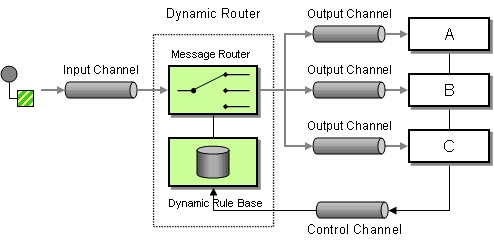Since we're on a major migration process of this website, some component documents here are out of sync right now. In the meantime you may want to look at the early version of the new website
https://camel.apache.org/staging/
We would very much like to receive any feedback on the new site, please join the discussion on the Camel user mailing list.
Dynamic RouterThe Dynamic Router from the EIP patterns allows you to route messages while avoiding the dependency of the router on all possible destinations while maintaining its efficiency. In Camel 2.5 we introduced a You must ensure the expression used for the Options
Dynamic Router in Camel 2.5 onwardsFrom Camel 2.5 the Dynamic Router will set a property (Exchange.SLIP_ENDPOINT) on the Exchange which contains the current endpoint as it advanced though the slip. This allows you to know how far we have processed in the slip. (It's a slip because the Dynamic Router implementation is based on top of Routing Slip). Java DSLIn Java DSL you can use the Which will leverage a Bean to compute the slip on-the-fly, which could be implemented as follows: Mind that this example is only for show and tell. The current implementation is not thread safe. You would have to store the state on the Exchange, to ensure thread safety, as shown below: You could also store state as message headers, but they are not guaranteed to be preserved during routing, where as properties on the Exchange are. Although there was a bug in the method call expression, see the warning below. Mind that in Camel 2.9.2 or older, when using a Bean the state is not propagated, so you will have to use a Processor instead. This is fixed in Camel 2.9.3 onwards. Spring XMLThe same example in Spring XML would be: @DynamicRouter annotationYou can also use the Dynamic Router in Camel 2.4 or olderThe simplest way to implement this is to use the RecipientList Annotation on a Bean method to determine where to route the message. In the above we can use the Parameter Binding Annotations to bind different parts of the Message to method parameters or use an Expression such as using XPath or XQuery. The method can be invoked in a number of ways as described in the Bean Integration such as
|

